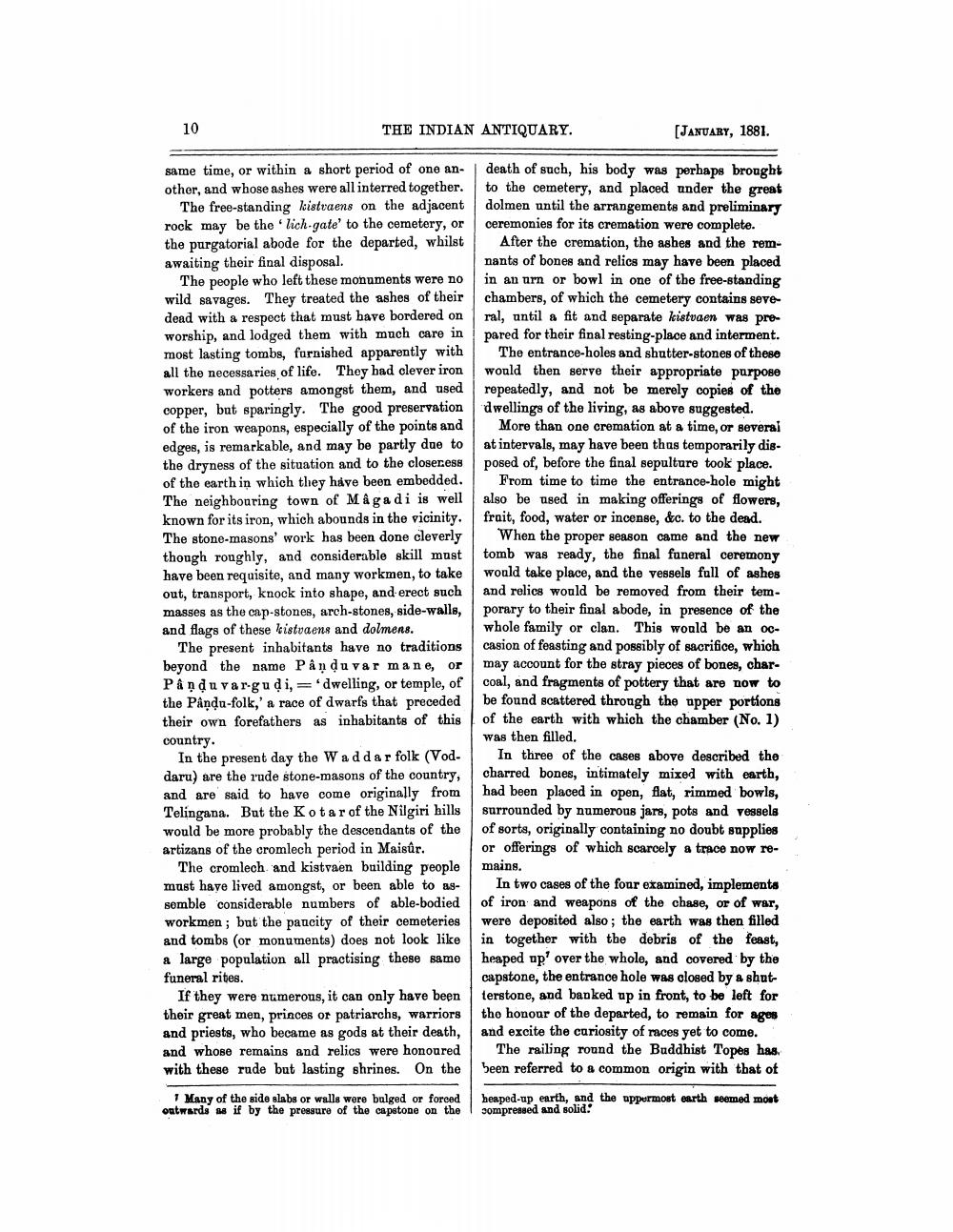________________
10
THE INDIAN ANTIQUARY.
(JANUARY, 1881.
same time, or within a short period of one an- death of such, his body was perhaps brought other, and whose ashes were all interred together. to the cemetery, and placed under the great
The free-standing kistvaens on the adjacent dolmen until the arrangements and preliminary rock may be the lich.gate to the cemetery, or ceremonies for its cremation were complete. the purgatorial abode for the departed, whilst After the cremation, the ashes and the remawaiting their final disposal.
nants of bones and relics may have been placed The people who left these monuments were no in an urn or bowl in one of the free-standing wild savages. They treated the ashes of their chambers, of which the cemetery contains sevedead with a respoct that must have bordered on ral, until a fit and separate keistvaen was preworship, and lodged them with much care in pared for their final resting-place and interment. most lasting tombs, furnished apparently with The entrance-holes and shutter-stones of these all the necessaries of life. They had clever iron would then serve their appropriate purpose workers and potters amongst them, and used repeatedly, and not be merely copies of the copper, but sparingly. The good preservation dwellings of the living, as above suggested. of the iron weapons, especially of the points and More than one cremation at a time, or several edges, is remarkable, and may be partly due to at intervals, may have been thus temporarily disthe dryness of the situation and to the closeress posed of, before the final sepulture took place. of the earth in which they have been embedded. From time to time the entrance-holo might The neighbouring town of Mâga di is well also be used in making offerings of flowers, known for its iron, which abounds in the vicinity. frait, food, water or incense, &c. to the dead. The stone-masons' work has been done cleverly When the proper season came and the new though roughly, and considerable skill must tomb was ready, the final funeral ceremony have been requisite, and many workmen, to take would take place, and the vessels full of ashes out, transport, knock into shape, and erect such and relics would be removed from their temmasses as the cap-stones, arch-stones, side-walls, porary to their final abode, in presence of the and flags of these kistvaene and dolmens. whole family or clan. This would be an oc
The present inhabitants have no traditions casion of feasting and possibly of sacrifice, which beyond the name Pân duvar mane, or may account for the stray pieces of bones, charPându vargudi, = dwelling, or temple, of coal, and fragments of pottery that are now to the Pându-folk,' a race of dwarfs that preceded be found scattered through the upper portions their own forefathers as inhabitants of this of the earth with which the chamber (No. 1) country.
was then filled. In the present day the Waddar folk (Vod. In three of the cases above described the daru) are the rude stone-masons of the country, charred bones, intimately mixed with earth, and are said to have come originally from had been placed in open, flat, rimmed bowls, Telingana. But the Kotar of the Nilgiri hills surrounded by numerous jars, pots and vessels would be more probably the descendants of the of sorts, originally containing no doubt supplies artizans of the cromlech period in Maisûr. or offerings of which scarcely a trace now re
The cromlech and kistvaen building people mains. must have lived amongst, or been able to as- In two cases of the four examined, implements somble considerable numbers of able-bodied of iron and weapons of the chase, or of war, workmen; but the paucity of their cemeteries were deposited also; the earth was then filled and tombs (or monuments) does not look like in together with the debris of the feast, a large population all practising these same heaped up' over the whole, and covered by the funeral rites.
capstone, the entrance hole was closed by a shutIf they were numerous, it can only have been terstone, and banked up in front, to be left for their great men, princes or patriarchs, warriors the honour of the departed, to remain for ages and priests, who became as gods at their death, and excite the curiosity of races yet to come. and whose remains and relics were honoured The railing round the Buddhist Topes has with these rude but lasting shrines. On the been referred to a common origin with that of
1 Many of the side slabs or walls were bulged or forced outwards as if by the pressure of the capetone on the
heaped-up earth, and the uppermost earth seemed most 3ompressed and solid.




